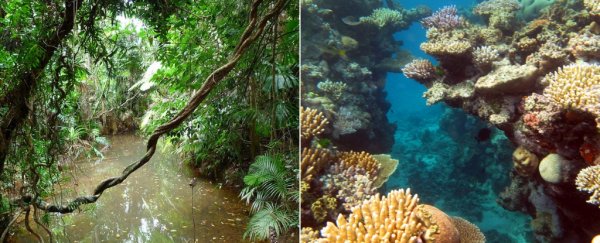Most of us know the Great Barrier Reef is facing a major crisis. A rapidly warming planet and a series of disastrous bleaching events have left this natural wonder a mere skeleton of its former self, with half the coral it contains already dead.
What many do not know, is that running parallel to the world's largest reef system for some 450 kilometres, another priceless marvel is on a similar crash course.
The wet tropics of far northern Queensland, including the world-renowned Daintree rainforest, have been around since the time of Gondwana, around 150 million years ago.
And even though the lush region takes up less than around 0.1 percent of the entire continent, it boasts over a third of Australia's mammal species, 41 percent of its freshwater fish species, a full 50 percent of its bird species, and a whopping 60 percent of its butterfly species.
It is, without a doubt, the oldest rainforest on Earth, home to an abundance of endemic, rare and ancient species, listed as the second most irreplaceable world heritage area out of more than 173,000 candidates.
Together with the Great Barrier Reef, both these natural wonders lie within David Attenborough's favourite place on Earth: far northern Queensland. And together, they face a bleak and uncertain future.
Previous reports have predicted that unless immediate action is taken, the wet tropics may lose half their endemic species by the end of the century.
In light of new findings from researchers at James Cook University, the Wet Tropics Management Authority now thinks this massive die-off could arrive even sooner.
"Extreme heat is the Wet Tropics World Heritage Area's coral bleaching event equivalent," said the management authority in a recent statement, "with some mountain adapted species, like the lemuroid ringtail possum, unable to survive even a day of temperatures above 29 degrees Celsius."
This past summer alone, temperatures on the highest mountain in the wet tropics hit an unprecedented 39 degrees Celsius six times. Following decades of deforestation, these heat waves could prove catastrophic.
Today, roughly 50 percent of tropical Queensland's forest has already been destroyed, and about 52 percent of the wet tropics is now under pasture.
Saved only by their world heritage status, these rainforests now face yet another crisis, and this time, it can't be roped off by a global authority.
After some of the worst heatwaves ever recorded in Australia, scientists are convinced that several key animals in the wet tropics are under severe and immediate threat from climate change.
With nowhere to hide from the oppressive heat, not even on the tallest peaks, various species of possum and bird, found nowhere else in the world, have begun climbing to obscurity like wisps of smoke.
If the trend continues, the authority warns that the lemuroid ringtail possum, which isn't even listed as endangered, may go extinct by 2022. The river ringtail possum, the green ringtail possum, and the tooth-billed bowerbird could soon follow.
The risk for the region is imminent and the losses irreplaceable, yet the wet tropics world heritage site receives only a fraction of the worldwide attention and finances that its neighbour does.
"While, understandably, the Great Barrier Reef has received significant funding to address climate change impacts in recent years," the statement reads, "investment in terrestrial World Heritage Areas has not been commensurate with the urgency for mitigating climate impacts on their World Heritage values."
With the nation facing an upcoming federal election, the head of the Australian Conservation Foundation, Kelly O'Shanassy, has asked political leaders to explain how they would protect these natural wonders from further harm.
"Ultimately we are witnessing the destruction by climate change of one of the most ecologically important and beautiful places in the world that we as Australians have promised to look after on behalf of all humankind," she said.
